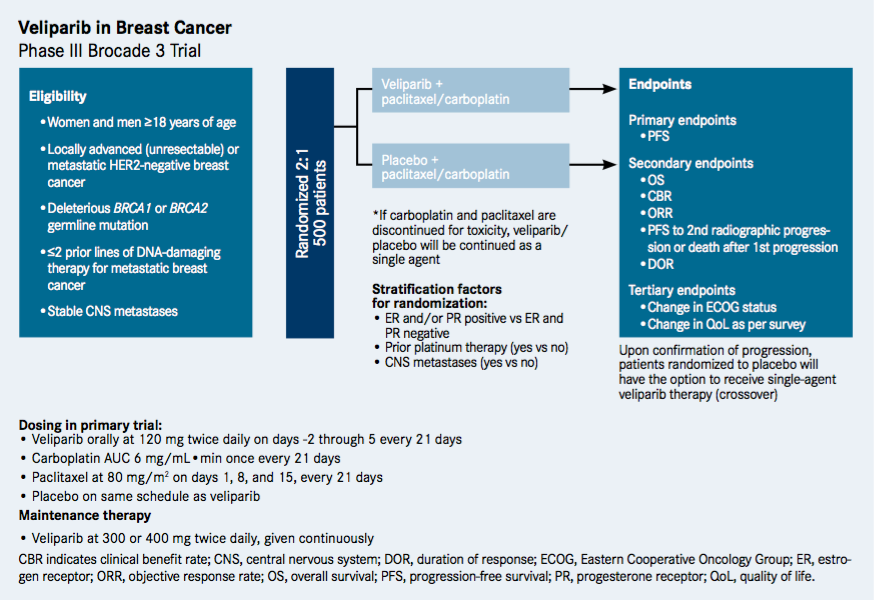Veliparib Facing Phase III Test in BRCA-Positive Breast Cancer
Researchers are seeking to determine whether adding the PARP inhibitor veliparib to a chemotherapy combination will improve outcomes for patients with HER2-negative, germline BRCA-associated metastatic or locally advanced breast cancer.
Shannon L. Puhalla, MD

Shannon L. Puhalla, MD
Researchers are seeking to determine whether adding the PARP inhibitor veliparib to a chemotherapy combination will improve outcomes for patients with HER2-negative, germline BRCA-associated metastatic or locally advanced breast cancer.
The international Brocade 3 trial, which is currently enrolling participants at more than 200 locations, seeks to randomize an estimated 500 patients in a 2:1 ratio to either veliparib with carboplatin and paclitaxel or a placebo plus the 2 chemotherapy agents (NCT02163694).
The phase III study is open to patients whose tumors are triple negative as well as those with estrogen receptor (ER)- or progesterone receptor (PR)-positive disease because the biomarker of interest is not the hormone receptor, it is the BRCA mutation itself, according to principal investigator Shannon L. Puhalla, MD.
“What we’re hoping to learn is whether, irrespective of hormonal status, the BRCA mutation is driving the response, as opposed to other factors,” said Puhalla, who is director of the breast cancer clinical research program at the University of Pittsburgh Cancer Institute, and assistant professor of medicine at the University of Pittsburgh School of Medicine.
If successful, the addition of veliparib to a chemotherapy regimen would provide another option for a sizable subgroup of patients with the mutation. Germline BRCA1 and BRCA2 mutations account for 5% to 10% of all breast cancers, and from 20% to 25% of hereditary breast cancers.1 “Where this study will fill a void is for the patient who requires chemotherapy, but also has a BRCA mutation,” said Puhalla. “Then there would be an advantage to giving the PARP inhibitor with chemotherapy.”
As a PARP inhibitor, veliparib targets a group of enzymes important in repairing DNA damage, blocking the proteins from allowing cancer cells to proliferate and enhancing the cytotoxicity of chemotherapy that also damages DNA.
Nearly 78% of patients who were treated with a combination of veliparib and carboplatin/paclitaxel responded to treatment in phase II clinical trial results presented at the 2016 San Antonio Breast Cancer Symposium.2 However, progression-free survival (PFS) and overall survival (OS) did not meet the threshold for statistically significant improvement compared with the same chemotherapy regimen plus placebo.
The median PFS was 14.1 months (95% CI, 11.5-16.2) for the veliparib arm and 12.3 months (95% CI, 9.3-14.5) for the placebo group (HR, 0.789; 95% CI, 0.536-1.162; P = .231). The median OS was 28.3 months (95% CI, 26.9-not reached) with veliparib versus 25.9 months (95% CI, 20.4-31.8) with placebo, respectively (HR, 0.750; 95% CI, 0.503-1.117; P = .157), although these data were not fully mature.

Puhalla and colleagues believe there were enough positive signals in the results to remain optimistic about the prospects for success in the Brocade 3 study. “In part, the hazard ratio that was being evaluated in the phase II study was a high bar to meet; the study was aggressively powered in a way that I think made the PFS harder to attain,” said Puhalla.
The phase II study did demonstrate that the backbone treatment of carboplatin and paclitaxel, which is not listed as a recommended dual therapy in the National Comprehensive Cancer Network guidelines for breast cancer, is extremely effective as first- or second-line therapy for patients who are BRCA mutation carriers. Puhalla indicated. “The control arm had a response rate upward of 60%,” she said.
However, Puhalla noted that it is difficult to administer the chemotherapy doublet for an extended period of time since patients are at risk for bone marrow toxicity, generally after 6 to 9 cycles, and would have to halt treatment. The phase III trial allows for veliparib/placebo monotherapy (depending on which arm the patient is on) if there is toxicity with combination treatment which is a key difference between the phase II and phase III trials.
In the phase II trial, the addition of veliparib to chemotherapy did not notably increase the incidence of adverse events (AEs). All-grade AEs occurred in 100% of the veliparib arm and 97.9% of the placebo arm; serious AEs occurred in 34.4% and 27.1% of the veliparib and placebo arms, respectively. The most common hematologic treatment-emergent all-grade AEs included anemia, febrile neutropenia, leukopenia, neutropenia, and thrombocytopenia.
The Brocade 3 trial is being conducted by AbbVie, which is also the company developing the drug. The study is expected to be completed in March 2018.
References
- BRCA1 and BRCA2: cancer risk and genetic testing. National Cancer Institute website. https://www.cancer.gov/about-cancer/causes-prevention/genetics/brca-fact-sheet#q2. Updated April 1, 2015. Accessed December 30, 2016.
- Han HS, Diéras V, Robson M, et al. Efficacy and tolerability of veliparib (V; ABT-888) in combination with carboplatin (C) and paclitaxel (P) vs placebo (Plc)+C/P in patients (pts) with BRCA1 or BRCA2 mutations and metastatic breast cancer: a randomized, phase 2 study. Presented at: 2016 San Antonio Breast Cancer Symposium; December 6-10, 2016; San Antonio, TX. Abstract S2-05.




